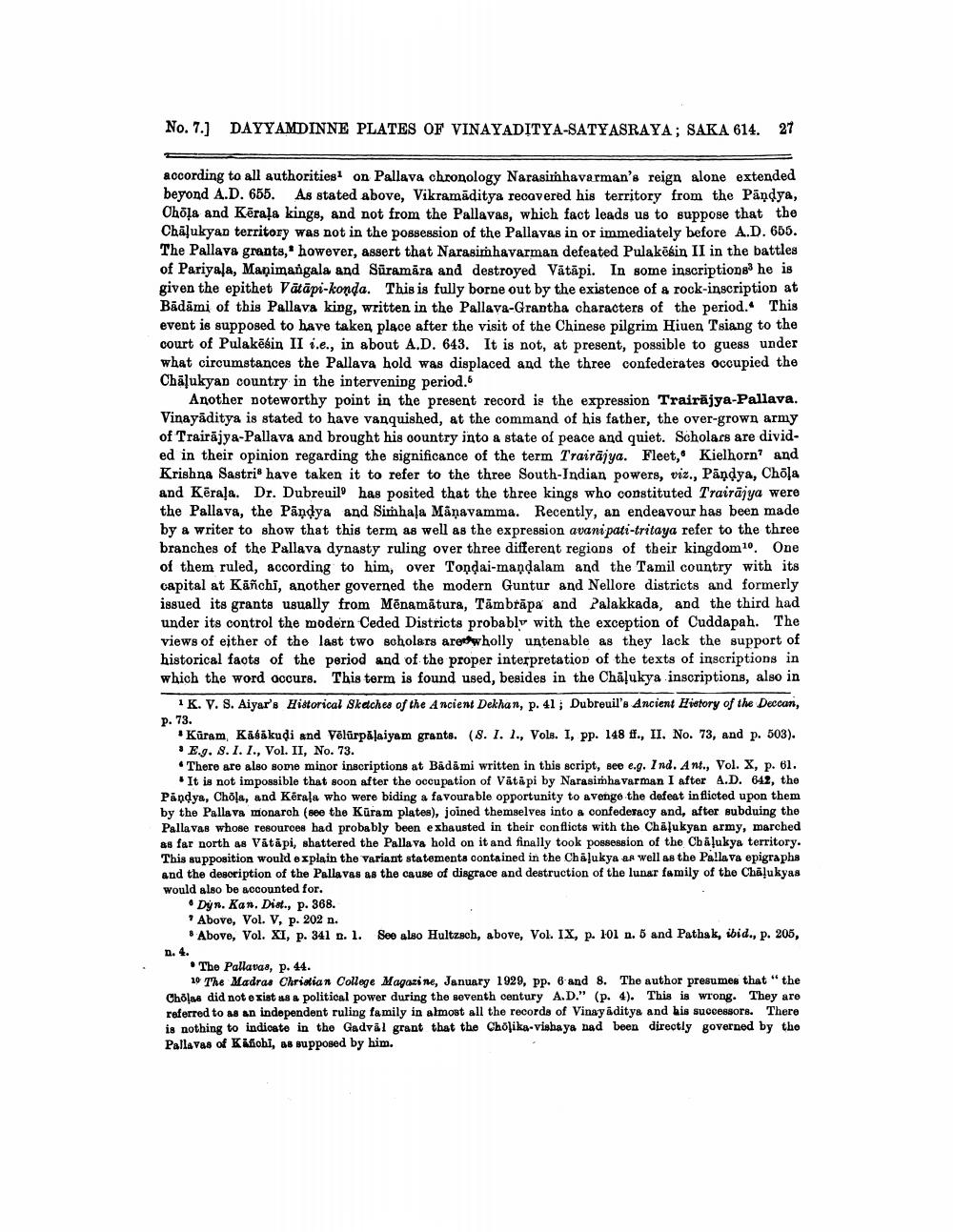________________
No. 7.] DAYYAMDINNE PLATES OF VINAYADITYA-SATYASRAYA; SAKA 614.27
according to all authorities on Pallava chronology Narasimhavarman's reign alone extended beyond A.D. 655. As stated above, Vikramaditya recovered his territory from the Pāņdya, Ohola and Kērala kings, and not from the Pallavas, which fact leads us to suppose that the Chāļukyan territory was not in the possession of the Pallavas in or immediately before A.D. 655. The Pallava grants, however, assert that Narasimhavarman defeated Pulakēsin II in the battles of Pariyala, Manimangala and Sūramāra and destroyed Vätäpi. In some inscriptions' he is given the epithet Vätāpi-konda. This is fully borne out by the existence of & rock-inscription at Bādāmi of this Pallava king, written in the Pallava-Grantha characters of the period. This event is supposed to have taken place after the visit of the Chinese pilgrim Hiuen Tsiang to the court of Pulakēsin II 1.e., in about A.D. 643. It is not, at present, possible to guess under what circumstances the Pallava hold was displaced and the three confederates occupied the Chalukyan country in the intervening period.
Another poteworthy point in the present record is the expression Trairājya-Pallava. Vinayāditya is stated to have vanquished, at the command of his father, the over-grown army of Trairājya-Pallava and brought his country into a state of peace and quiet. Scholars are divided in their opinion regarding the significance of the term Trairājya. Fleet, Kielhorn? and Krishna Sastris have taken it to refer to the three South Indian powers, viz., Pāņdya, Chola and Kerala. Dr. Dubreuile has posited that the three kings who constituted Trairājya were the Pallava, the Pandya and Simhala Mänavamma. Recently, an endeavour has been made by a writer to show that this term as well as the expression avani pati-tritaya refer to the three branches of the Pallava dynasty ruling over three different regions of their kingdom 10. One of them ruled, according to him, over Tondai-mandalam and the Tamil country with its capital at Kāñchi, another governed the modern Guntur and Nellore districts and formerly issued its grants usually from Mēnamātura, Tāmbrāpa and Palakkada, and the third had under its control the modern Ceded Districts probably with the exception of Cuddapah. The views of either of the last two scholars are wholly untenable as they lack the support of historical facts of the period and of the proper interpretation of the texts of inscriptions in which the word occurs. This term is found used, besides in the Chalukya inscriptions, also in
1K. V. S. Aiyar's Historical Skaches of the Ancient Dekhan, p. 41; Dubreuil's Ancient History of the Deccan, P. 73.
* Küram, Kābākudi and Vēlārpāļaiyam grants. (8. 1. 1., Vols. I, pp. 148 ff., II. No. 73, and p. 503). • E.g. 8. 1. I., Vol. II, No. 73. . There are also some minor inscriptions at Badami written in this script, see e.g. Ind. Ant., Vol. X, p. 61.
It is not impossible that soon after the occupation of V&tapi by Narasimha varman I after A.D. 642, the Pandya, Chola, and Kerala who were biding a favourable opportunity to avenge the defeat inflicted upon them by the Pallava monarch (see the Kuram plates), joined themselves into a confederacy and, after subduing the Pallavas whose resources had probably been exhausted in their conflicts with the Chilukyan army, marched as far north as Vātāpi, shattered the Pallava hold on it and finally took possession of the Chalukya territory. This supposition would explain the variant statements contained in the Chalukya as well as the Pallava epigraphs and the description of the Pallavas as the cause of disgrace and destruction of the lunar family of the Chalukyas would also be accounted for.
• Dyn. Kan. Dist., p. 368. ? Above, Vol. V, p. 202 n.
* Above, Vol. XI, p. 341 n. 1. See also Hultzsch, above, Vol. IX, p. 101 n. 5 and Pathak, ibid., p. 205, n. 4.
The Pallavas, P. 44.
10 The Madras Christian College Magazine, January 1929, pp. 6 and 8. The author presumes that "the Cholae did not exist as a political power during the seventh century A.D." (p. 4). This is wrong. They are referred to as an independent ruling family in almost all the records of Vinay iditya and his successors. There is nothing to indicate in the Gadvil grant that the Cholika visha ya nad been directly governed by the Pallavas of Káfichi, as supposed by him.




